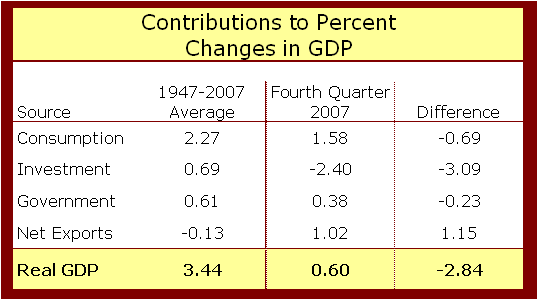Gross Domestic Product growth (GDP) slowed to an annual rate of 0.6 percent in the fourth quarter of 2007 according to Thursday’s release from the Bureau of Economic Analysis. AIER employs GDP as one of six coincident indicators of business cycle activity to show us where the economy actually is, and usually to provide confirmation of trends previously signaled by the leading indicators.
Since last spring our leading indicators have been signaling that the probability of economic contraction exceeded the probability of continued expansion of the current business cycle. For two quarters after our leading indicators turned south, overall economic activity continued expanding at a rapid pace among all of our coinciders – including GDP growth of 3.8 percent in the second quarter and 4.9 percent in the third quarter (annualized rates).Currently our coincident indicators are not signaling that the economy is contracting, but the recent weakness in the GDP number, along with some weakening in nonagricultural employment and industrial production suggests that the economy is in fact slowing.
Though GDP is intended to be a measure of the total production of goods and services in the U.S. (i.e. sources of income) more attention is typically paid to how this total output is used. In a future Research Reports article, we will explore this issue in further detail, but for this article we will focus on the more common approach employed.
Uses of GDP include the sum of consumption (C), investment (I), government spending (G) and net exports (NX). The chart below shows how each of these components of GDP has varied since 1947. Between 1947 and 2007 real GDP has increased by roughly 3.4 percent annually. Consumption has made up 66 percent of this growth, with investment accounting for 20 percent, government spending another 18 percent, and net exports representing a four percent drag on growth rates.
What has accounted for the slowdown in growth during the fourth quarter of 2007? As the table below illustrates, virtually all of the slowdown has been due to a reduction in investment. Investment in the national income accounts refers to spending commodities that will be used in a production process for more than one year, including replacements and additions to the capital stock. In other words, it is spending on long-lived goods that are used to produce future consumption goods.
Business and household investment fell at an annualized rate of 2.4 percent during the fourth quarter, over three percentage points below its historical average. While consumption and government expenditures were also slightly off from their historical averages, continued strength in American exports (driven by the weak dollar) has kept overall GDP growth from dipping into negative territory.
The slowdown in investment activity has been driven by sharp declines in residential fixed investment and reductions in private inventories. The decrease in residential fixed investment reflects the well-documented slowdown in the housing sector. The reduction of inventories by private businesses during the fourth quarter, while a drag on current GDP, suggests that backlogs in the overall economic system may be lightening, enabling the economy to grow more quickly when the situation turns around.
However, investment in nonresidential structures and equipment has remained strong (near or above historical averages). This is comprised of investments in new nonresidential structures including hotels/motels, new machinery purchased by private businesses, and purchases of furniture and vehicles used for business activities. Incidentally, the final chart below compares the historical experience of residential investment and nonresidential investment over the course of the business cycle since 1947. Nonresidential investment (the red line) has declined during every one of the 10 recessions since 1947. Residential investment (the blue line) has peaked before almost every recession, with 2001 being the outlier. If we are, in fact, experiencing a recession right now, then this would be the first time the economy has contracted since 1947 without the nonresidential investment sector also contracting.



Well done! Unlike the author of the topic 😉